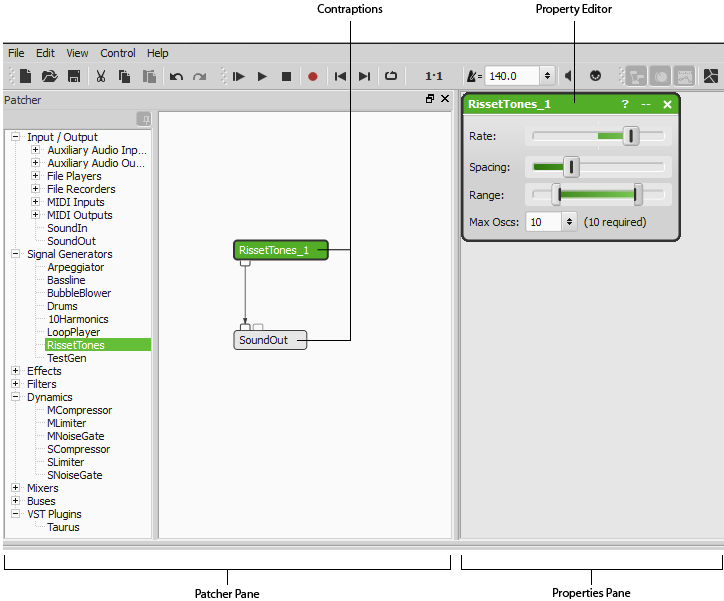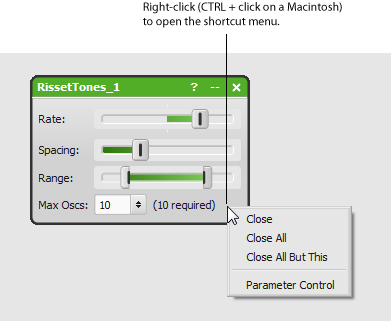| AudioMulch Help > Adjusting Contraption Properties | Previous Next |
Using Contraption Property Editors

Most contraptions have their own Property Editors, which are displayed in the Properties Pane. Property Editors have controls (such as knobs and sliders) that you can use to change properties, resulting in changes to the sound. In this module we show you how to open and hide Property Editors, how to move them, what the title bar buttons mean, and how to use shortcut menus.
How to open and hide Property Editors
| To open a Property Editor do one of the following: |
|---|
The Property Editor will open in the Properties Pane. |
| To hide a Property Editor: |
|---|
The Property Editor will disappear from the Properties Pane. Note: hiding a Property Editor doesn't delete the contraption. You can only delete a contraption in the Patcher Pane. Once you've hidden a contraption's Property Editor you can reopen it using the method above. The Property Editor will reappear in the same location with its settings intact. |
Buses and AuxIn/AuxOut contraptions do not have Property Editors as they do not have properties to edit.
How to use title bar buttons
Each Property Editor has a title bar - this is the area at the top of the Property Editor that contains the name of the contraption, and three buttons. The layout of the title bar is slightly different on Windows and Macintosh, as shown below:


| Button | How to use it and what it does |
|---|---|
| ? (Help) | Click on the ? button to open the Help File for that contraption. |
| X (Close) | Click on the X button to hide the Property Editor. Note: If you have multiple Property Editors that you want to hide, SHIFT+click on one of the X buttons to hide them all at once. |
| -- (Preset) | Click on the -- button to open the Contraption Presets window. Note: The preset button will only display as -- if no presets have been stored. Once presets have been stored, this button will display a number instead, like this: |
How to move Property Editors
Property Editors can be moved around the Properties Pane, which is useful if you want to organize them.
| To move a Property Editor: |
|---|
|
How to use the Property Editor shortcut menu
Property Editors have their own shortcut menu that you can use to close the Property Editors and to open the Parameter Control window.
| To open this shortcut menu: |
|---|
|
You can then choose from the following menu items:
| Close | Closes the Property Editor. An alternative to using the X button. |
| Close All | Closes all of the Property Editors in the Properties Pane. An alternative to using the X button. |
| Close All But This | Closes all of the Property Editors in the Properties Pane, except for the one you are clicking on. An alternative to using the X button. |
| Parameter Control | Opens the Parameter Control window with the current contraption selected. This allows you to map contraption parameters to a MIDI control source or to make changes to parameter mappings. |
Note: contraption controls such as knobs and sliders have a different shortcut menu.
See Also
- Creating and Deleting Contraptions
- Storing, Recalling and Managing Contraption Presets
- Using Common Contraption Controls
- Controlling AudioMulch Parameters from MIDI
| Previous Next |






